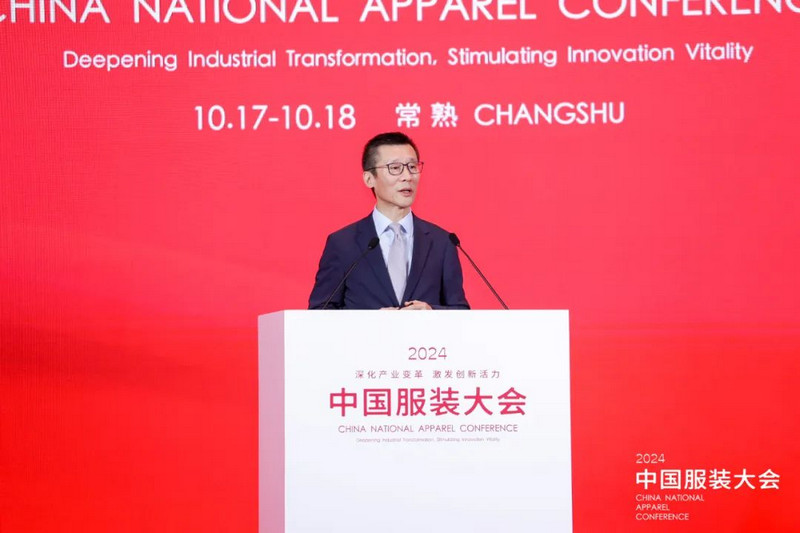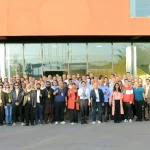 Chen Dapeng, Vice President of China National Textile and Apparel Council and President of China National Garment Association
Chen Dapeng, Vice President of China National Textile and Apparel Council and President of China National Garment Association
Speech of Chen Dapeng
In 2024, the overall economic operation of China’s clothing industry showed a trend of restorative growth. From January to August, most operating indicators achieved a year-on-year recovery based on last year’s low base. However, since the second quarter, due to weak market demand, the cumulative growth rate of domestic sales has slowed down month by month. At the same time, exports have been under pressure and the trade environment has become more complex. The growth rate of industry profits has declined significantly, and the overall operation of the industry is facing great pressure.
At present, although the traditional sales peak season in autumn and winter has brought about a seasonal improvement in local market conditions, compared with the traditional peak seasons in previous years, the overall market buying and selling atmosphere is weak, the prices of conventional products remain weak, and corporate profit margins are still slim. Most companies are cautiously optimistic about the future market outlook, and the industry’s pressure recovery trend will continue.
Production remained stable overall. From January to August, the output of enterprises above designated size in the industry increased by 5.7%, with knitted clothing growing fastest, up 9.5%, accounting for 69% of the total clothing output, an increase of nearly 3 percentage points over last year; from the perspective of major categories, the volume of down clothing, suits, and shirts decreased from January to August. From the perspective of industrial added value, the overall production and sales situation is still good.
The growth rate of the domestic sales market has slowed down. In the domestic sales market, the year-on-year decline was 0.2% from January to August, and the online retail sales of clothing products increased by 5%, which was 13.1 and 5.9 percentage points slower than the same period last year. Since the second quarter, the growth rate of the domestic clothing market has slowed down significantly month by month. The growth of per capita disposable income of residents has slowed down, and the consumption momentum is insufficient; the growth is mainly in the online channel, but the growth rate is also falling, and the support for market growth is weakening; the structural changes in consumption, the pursuit of cost-effectiveness, also include the price involution of e-commerce channels; changes in consumption structure, product structure, and channel structure are all affecting prices and benefits as a whole.
The export market continues to be under pressure. Since the beginning of this year, China’s clothing exports have generally been better than expected, but the pressure is gradually increasing. The world economic growth recovery is weak and the environment is complex. Emerging markets such as Central Asia, ASEAN, and Latin America and new cross-border e-commerce formats have played an important role in driving the market. Therefore, from the changes in the product structure and market structure of the two markets, it can be seen that price declines are bound to affect the growth of benefits.
The industry’s operating conditions showed a slight increase in revenue, a decrease in total profit and profit margin. At the same time, the proportion of the three expenses decreased, and the industry efficiency improved, reflecting the improvement of management and operating quality, but it was still not enough to offset the impact of the decline in product prices.
Investment is a bright spot. The investment growth rate is higher than the average of China’s manufacturing industry and China’s textile industry. On the one hand, we can see confidence, and on the other hand, we can see that transformation and upgrading are accelerating.
The above is the overall situation of the industry operation since this year, mainly based on the data of enterprises above designated size. Although the scale and situation of enterprises are different, everyone is in the same boat and knows their own situation. For some time, the association has communicated with enterprises in various places. Many enterprises said that this year is particularly difficult, which may be the most difficult year in decades. They are anxious, uncertain and even confused… From the above overall operation analysis, it can be seen that our enterprises are facing relatively large difficulties and pressures this year, which is also objective.
What is the core problem?
On the one hand, as a consumer goods industry, in such a downward economic cycle, the growth and development of the industry has a lot to do with the slowdown in residents’ income growth, especially the lack of consumer confidence. However, on the other hand , I think the most important thing is that we are still in an era of great changes, great adjustments, and great turmoil. The problems we face are not simple economic, consumption, trade and other issues. The most essential root is that the development of digital technology is bringing about major technological progress for mankind, and every major technological progress in human history will inevitably bring about major changes in the economy and society, from quantitative change to qualitative change, economy, society, industry, market, etc., of course, including politics. Behind the geopolitical game is the struggle for technological leadership. Technology leads to economic change, and the market leads to industrial change.
Therefore, for the Chinese clothing industry, we are now in a “deep adjustment and transformation period” , which is actually the transformation period of our industry from industrial economy to digital economy. Today, the difficulties, pressures and challenges we face are the pain of change in this process, which is the market’s pressure. The traditional growth mode, development path and model have reached a bottleneck, which means that we need to improve efficiency and benefits, improve total factor productivity and improve development quality in a completely new way.
Rely on what?
The Third Plenary Session of the 20th CPC Central Committee clearly proposed relying on new quality productive forces. This is a highly forward-looking theoretical breakthrough in the era of change, and everyone is learning from it.
I list the core contents:
New quality productivity is a contemporary advanced productivity that is spawned by revolutionary technological breakthroughs, creative allocation of production factors, and deep industrial transformation and upgrading. It is based on the qualitative change of workers, labor materials, labor objects and their optimized combination, with the improvement of total factor productivity as its core symbol, and innovation-driven is the key. New quality productivity is productivity that breaks away from the traditional growth path and meets the requirements of high-quality production, that is, productivity that is more innovative, more integrated, and more embodies new connotations in the digital economy era.
“New” embodies new technology, new model, new format, new momentum, and new advantages, while “quality” focuses on high performance, high efficiency, and high quality, which means improving efficiency and benefits and improving the quality of development. New quality productivity is the productivity in the digital economy era, which brings about the transformation and upgrading of industries, the transformation of industrial forms, and the improvement of industrial levels.
For the industry, new productivity refers to scientific and technological productivity, fashion productivity, and green productivity. It is necessary to “deepen reform and innovation, stimulate innovation vitality” through the development of new productivity, industry-oriented, government-driven, and enterprise-innovated, comprehensively promote the transformation and upgrading of industries, and build a new industrial ecology and organizational system in the digital economy era.
Specifically, scientific and technological productivity is the core part of new productivity and the key force to promote revolutionary breakthroughs in all aspects of the industry. New technologies are fully and deeply integrated to accelerate the subversive reconstruction of the industrial ecology and the formation of new industrial quality and efficiency, and to accelerate the application of digital technology, big data, and artificial intelligence in design creativity, product development, production management, and marketing services.
Cultural productivity is the attribute of the industry. The clothing industry is not only an industry of material creation, but also an industry of cultural and spiritual creation. Cultural creativity is the most important support for the value creation of the industry. We must study contemporary lifestyles and cultural development. Products must conform to contemporary aesthetics. The brand’s cultural innovation and cultural creation must reflect the attitudes and propositions of contemporary culture and enhance the industry’s cultural creativity and creativity.
Green productivity is the industry’s development concept and value. Through innovation in technology, models, and management, we build a responsible industrial ecosystem, a green supply chain system, and an industry integrity system to achieve a modern society where humans and nature coexist in harmony.
For our company:
First, we must completely change the traditional concept and approach of development, balance the relationship between differentiation and scale, follow the general trend, and develop in an innovation-oriented, endogenous and connotation-oriented manner, do it right, do it well, and make it stronger, focus on efficiency and benefits, and pay attention to development quality.
Second, embrace the era of technological change, innovate manufacturing paradigms and business models through the application of digital technology, big data, and artificial intelligence, and form new capabilities to keep up with the times. This is the fundamental basis for enterprises to overcome decline and aging. At the same time, technological change brings about changes in concepts and thinking, and updates to organizations, systems, talents, and management. Building an organizational gene that keeps pace with the times is an important manifestation of the core competitiveness of enterprises.
Third, as a consumer goods industry, the starting point and the end point are consumers. Research on consumers, lifestyles and cultural development is the source of innovation for enterprises. To achieve specialization and innovation through differentiation and uniqueness, insist on creating value, innovation and customer first, and “cost-effectiveness” and “heart-price ratio” based on style, quality and taste rather than price are the key to creating brand value.
Fourth, the digital economy era is an era of interconnected symbiosis, synergy and win-win, forming a common value relationship with upstream and downstream and all stakeholders, forming a healthy growth force with altruism, and constantly iterating and evolving with long-termism. It comes from passion, always sincere, do the right and difficult things, and believe in the power of time.
Today, in the great changes of the times, the old order is being broken and a new order is being established. History is like this, and it will eventually move from the disorder of change to order, to a new order and a higher level. We must see the general trend and see that a new industrial ecology of a new era is taking shape. This is our opportunity to become stronger again, and our industry will surely usher in a broader development prospect. In this process, there are always people who are anxious and confused, but there are also people who have already identified the direction and are running at full speed.
In short, “A thousand ships pass by the side of the sunken boat, and a thousand trees bloom in front of the dead tree.”
Thank you everyone.





